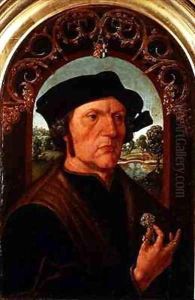Jacob Cornelisz Paintings
Jacob Cornelisz van Oostsanen, born around 1470 in Oostzaan, a small village north of Amsterdam, was an influential early Dutch painter and printmaker during the Renaissance period. He is often considered one of the key figures in the development of Northern Renaissance art. Not much is known about his early life or training, but it is believed that he may have been a pupil or follower of the Haarlem painter Geertgen tot Sint Jans.
Jacob Cornelisz moved to Amsterdam, where he became one of the city's foremost artists. He was granted citizenship in 1500, and his workshop flourished, producing altarpieces, portraits, and prints. His style was characterized by detailed landscapes, elaborate costumes, and a keen interest in the effects of light. He was innovative in his use of color and was one of the first to bring Italian Renaissance influences into Netherlandish art.
One of Cornelisz's significant contributions to art was his work in printmaking. He was among the first in the Northern Netherlands to produce colored woodcuts, which involved printing images from multiple blocks in different colors, a complex and skilled process. His prints were widely distributed, which helped to disseminate his style and the Italianate elements found within it across Europe.
Cornelisz's death occurred in 1533, in Amsterdam. By this time, his son, Dirck Jacobsz, and his nephew, Cornelis Buys, had also become accomplished artists, continuing the family tradition. Jacob Cornelisz's legacy is evident in the way he bridged Northern European art with the Italian Renaissance, influencing the course of Dutch painting and printmaking for generations.
